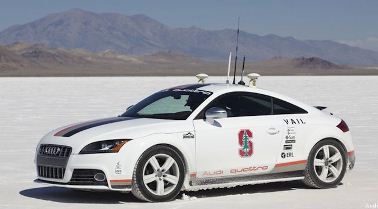Self-driving cars captivate us, but what about safety?
JoAnna Haugen
At the 2012 International Consumer Electronics Show (CES), self-driving cars took center stage. But in the eyes of one automaker, the focus should be on the safety features, not on the gee-whiz futuristic nature of the cars.
In a speech at CES, Mark Templin, vice president and general manager of Toyota’s Lexus luxury brand, said: “Simply put, our goal is to eliminate future traffic fatalities and injuries.”
In September, the Los Angeles Times reported that industry, traffic and insurance experts were in alignment on the traffic safety aspects of self-driving cars.

“This is the future,” Adrian Lund, president of the Insurance Institute for Highway Safety, told the Times. “Vehicles are designed to protect people when crashes happen, but it would be even better to prevent crashes from happening altogether.”
At CES, Lexus showcased its version of the self-driving car – an “advanced active safety research vehicle.” Audi also showed off a self-driving car and announced it had gained permission to test the car in Nevada.
Lexus emphasized the safety benefits of its driverless car. Among them are a 360-degree laser that can detect objects up to 230 feet; radar sensors on the front and sides that can sense surrounding objects and people; and cameras that monitor traffic conditions. The Lexus self-driving car can automatically brake if it senses an imminent accident or starts to drift across lanes.
Templin said the Lexus technology is designed to help motorists avoid danger and eventually may evolve into a fully self-driving car. Lexus envisions a car equipped with “an intelligent, always attentive co-pilot whose skills contribute to safer driving,” he said.
As for Audi, it took advantage of CES to shine a spotlight on the self-driving features of its driverless car more so than the safety aspects. The automaker touted the car’s “piloted driving” and “piloted parking” components.
This is how Audi explained the self-driving car in a news release:
“The term ‘piloted’ is used advisedly, as Audi envisions motorists enjoying the convenience of allowing the car to handle mundane stop-and-go driving conditions, for example, while still being able to take control of the car when needed. In this way, the technology is similar to auto-pilot systems found on jetliners. Likewise, autonomous, or piloted, parking would let future Audi models park safely without a driver at the wheel in in tight parking spaces.”
Audi and Lexus aren’t the only companies promoting self-driving cars. Internet search giant Google and tire manufacturer Continental also are working on “autonomous” vehicles.
An article on Time.com pointed out that the safety record of self-driving cars “is impressive so far. In the first 300,000 miles, Google reported that its cars had not had a single accident. Last August, one got into a minor fender-bender, but Google said it occurred while someone was manually driving it.”
In 2012, a report from consulting powerhouse KPMG and the nonprofit Center for Automotive Research declared the self-driving car is “the next revolution” in the auto industry. The Institute of Electrical and Electronics Engineers (IEEE) predicts that up to three-fourths of all vehicles on the road in 2040 will be self-driving.
Self-driving cars already are allowed on roads in California, Florida and Nevada.
The Center for Automotive Research’s Richard Wallace said in a news release: “Some may ask if it is still just science fiction or if the market will accept them and pay for them. We think the answer is a resounding yes – the marketplace will not merely accept self-driving vehicles, it will be the engine pulling the auto industry forward.”
